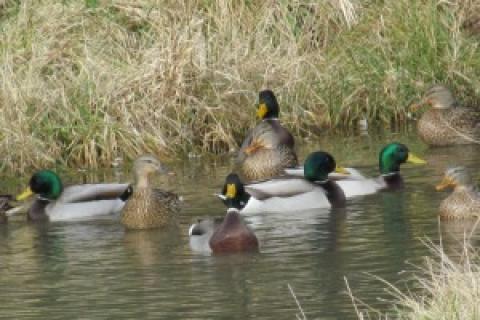
After enduring months of hunting pressure on sprawling lakes, bays and sounds, there’s nothing a late-season duck wants more than a quiet, secluded spot to hide out. Small, neglected potholes and ponds are magnets for January ducks and hotspots for the hunter who takes the time to locate these gems.
The U.S. Fish and Wildlife Service estimates there’s a pond within ten miles of 80 percent of the U.S. population. You can locate these mini-duck habitats in several ways. Simply driving backcountry roads and stopping to talk with farmers or mail carriers can yield great results. Topographic maps and Google Earth are also great resources. You can even place a call to your local game warden or wildlife biologist.
Concentrate on locations isolated from human traffic. The more hideaways you locate, the better the odds that one of your spots will hold ducks on any given day. Besides all-weather ponds, take note of low spots near rivers that overflow during heavy rains. Also be sure to check where beavers have dammed up small creeks.
Two basic strategies work well for these waters—jump shooting or waiting for the birds to come to you.
 |
| Isolated ponds can be honey holes for late season mallards. Jump shooting or flush-and-wait tactics are best when birds are already on the water. |
Jump Shooting
This is one of the most exciting tactics for pond ducks, since it entails stalking and fast-paced shooting. If possible, scout from a distance with binoculars and try to see if any birds are home. Take note of how many are present and where they’re located. Look over the topography to see where ditches, hills or brushy vegetation will allow the closest stalk.
You need to get within 40 yards or less for good jump shooting. As you stalk, keep a low profile and move silently. Coming up behind the dam is often the best approach. Two hunters can stalk together if you know the location of the birds. If the pond is larger and you don’t know exactly where the ducks are, it’s best to move in from two different angles. Always be aware of your partner’s location to ensure safe shooting lanes.
When a flock of 4-40 ducks suddenly rises up, it’s important to force yourself to select one target. Once you drop that bird then pick out another duck. You’d be surprised how easy it is to miss when you shoot at the flock as a whole.
A good retriever is a luxury when it comes to collecting the birds. If you don’t have one, bring waders or a rod-and-reel with a treble-hook lure to retrieve your quarry.
The Waiting Game
A second tactic used for ponds involves waiting for the birds to come to you. You can setup before daylight and await the ducks’ arrival or flush them off without shooting and anticipate their return. With either approach, the technique is basically the same. You’re relying on the appeal of that resting area to bring in the birds.
If ducks are on the water, flush them gently, and in small groups if possible. You don’t want to totally scare them, just worry them a bit. That way they’ll return in small flocks that offer extended shooting. You can set out 6-12 decoys if you choose. Sometimes the dekes help, but often I’ve simply waited by the pond in some brush or a makeshift blind and had birds pour back in by the dozens.
If you’ve set up on a pond before dawn, ducks will usually come pitching in at first light. If you flush birds off during the day, expect to wait 5-60 minutes before they return. Of course they won’t always come back. That’s the chance you take with this tactic.
When the ducks do come back to these small bodies of water, they’ll circle warily at first. But soon enough, you’ll hear that exhilarating rush of wings beating the cold winter air, then watch transfixed as they pitch down confidently into shooting range. It’s one of the sweetest of all waterfowling experiences, and you can enjoy it for free on millions of small ponds and potholes scattered throughout the country.
Gear for Pond Hunts:
• 12-20 gauge shotgun, improved-cylinder or modified, 2-4 shot.
• Camouflage from head to toe.
• Waders, retriever or rod-and-reel with treble hook lure.
• Decoys and calls—optional.
• 7-10 power binoculars.
- 5772 views

